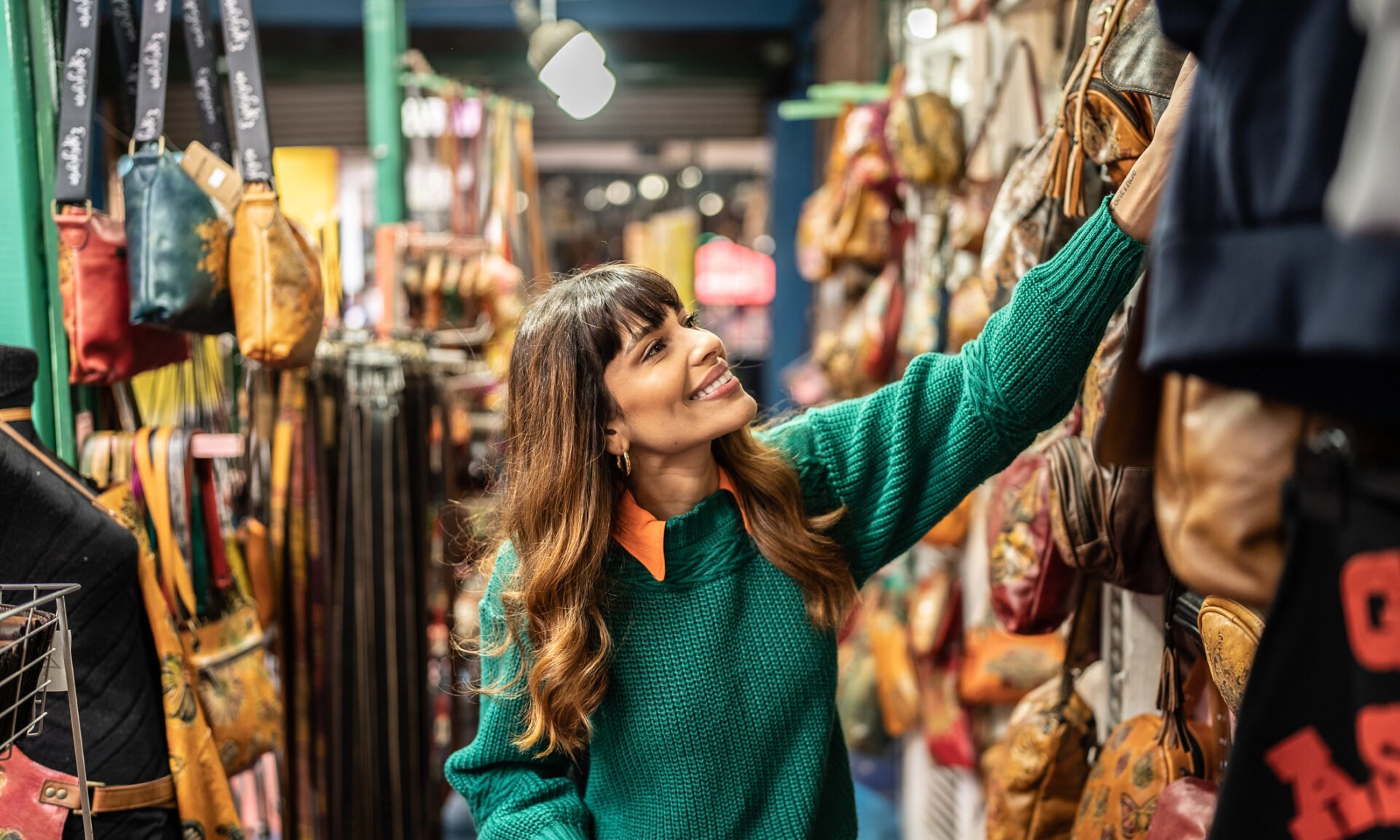I Saved $250 by Thrifting Holiday Gifts Before Black Friday
I scored $350 worth of holiday toys and books for just $100 by shopping secondhand. Learn my gift goals, shopping strategy and secondhand tips.

Many, or all, of the products featured on this page are from our advertising partners who compensate us when you take certain actions on our website or click to take an action on their website. However, this does not influence our evaluations. Our opinions are our own. Here is a list of our partners and here's how we make money.
The holidays are closing in, which means the pressure to shop sales is reaching a fever pitch. But, this holiday season feels a little different. With the government shutdown still underway, the high cost of groceries and tariffs driving up prices on toys and other items on my shopping list, I’m not feeling jolly about the retailer hype over 40% off.
Almost three-quarters of 2025 holiday shoppers (74%) expect tariffs to affect their gift shopping, whether that’s by making things more expensive or causing shortages, according to a recent NerdWallet study.
Tariffs are certainly on my mind. So, instead of shopping the way I always do — online and in person at some of my favorite stores — I decided to try something different this year: thrifting my kids' Christmas gifts.
The secondhand market offers an alternative — one that’s kinder to my budget and to the planet. By starting before Black Friday sales begin and scouring thrift stores, kids’ resale chains, and online marketplaces, I’m slowly finding gifts my kids will love at a fraction of regular retail prices.
Why thrifting makes sense in this economy
Shopping secondhand for kids items might feel like an obvious way to save, but it could lead to bigger savings than you may expect. If you’re looking for brand-new baby gear and other essentials, tariffs have created a pricier downside: Because the majority of baby gear is produced in China — a country hit heavily by these policies — these items are likely to cost parents more.
A 2025 congressional analysis reported that new parents in the U.S. are paying 24% more for the total cost of Amazon’s most popular stroller, car seat, crib, high chair and baby monitor since the tariffs went into effect.
But it’s not just the baby essentials that have gone up in price — toys are also likely to be more expensive this holiday season.
“The vast majority of toys imported into the U.S. come from countries heavily hit by tariffs,” says Elizabeth Renter, NerdWallet’s senior economist. “Some price increases due to tariffs are inevitable, and we’re likely to see these impacts in the months ahead.”
“Toy shoppers this holiday season will need to be discerning to find the best deals,” Renter says.
Find secondhand gifts in store and online
To find the best deals, you have to know where to look and consider how you prefer to shop. For example, if you live in an area with lots of secondhand stores and kids’ resale chains, such as Once Upon a Child, you might want to take multiple trips over the course of weeks or months to be the first to shop new items and examine potential purchases for quality.
If online shopping is a better fit, try searching for specific items on Facebook Marketplace and neighborhood buy nothing groups from the comfort of your home. You can enter your exact search terms and filter by the distance from your home. While you do eventually have to leave your house to pick up the items from the seller, this is a great way to find exactly what you’re looking for.
Other options, like eBay and Mercari, offer the same online convenience but allow you to ship items directly to your home. Include search terms such as “new in box” or “lightly used” to find great quality items at a significant discount.
» MORE: Want extra holiday shopping money? Explore how to sell things online
Set your intentions for gifting
Once you’ve mapped out your secondhand shopping spots, it’s time to think about your holiday gift strategy.
Last year, I went overboard. My kids would’ve been happy with half the gifts they unwrapped, so this year I wanted a clearer plan. Thrifting is a marathon, not a sprint, and it’s easy to get carried away when everything feels like a bargain.
I landed on a simple rule: something they want, something they need, something to wear, and something to read. I also tried to choose gifts that build on toys they already enjoy and encourage my kids to play together.
Here’s my list: A train table, train set and Little People farm set for my son; dress-up clothes and a STEM learning game for my daughter; and a stack of books tailored to both their interests.
Hunt for tariff-proof toys
My first stop was at a local church’s annual kids’ consignment sale, where I scored a Frozen dress-up gown for $6 (regularly $54.99 on Disney’s website) and an Osmo learning game for $10 ($93 on Amazon). I even grabbed a winter coat for my son for $11 ($24.99 at H&M).
Not everything was a win. Train tables were priced at $100 each — about the same as new. There was a Paw Patrol tower I knew my kids would love, but it was missing a piece so I passed.
A few days later, I checked out nearby kids’ consignment shops with a bag of old clothes and toys to consign. I found one of my big-ticket items — a giant Thomas the Train play set with accessories — for $49.99 ($118.99 on Amazon). I got 20% off for making a purchase on the same day I consigned, knocking an additional $10 off the price.
Books were harder to come by in-store, so I turned to Book Outlet, a discounted online shop. After narrowing my search by age and genre, I picked up a three-book series for my daughter for $20.47 ($28.53 on Amazon) and five Daniel Tiger paperback books for my son for $11.68 ($30.38 on Amazon).
All told, I’ve spent about $100 on $350 worth of toys and books. I haven’t checked everything off my list yet, but with weeks to go before the holidays, there’s time to keep looking.
Secondhand safety tips
Thrifting can save you money, but some items are safer to buy new.
“At Consumer Reports, we recommend buying new safety gear like car seats and strollers and cribs whenever possible,” says Jessica Waller, baby and health writer at Consumer Reports.
“Car seats, in particular, are pretty high risk to buy secondhand because you can't confirm if they've been involved in a crash,” Waller explains.
“Sometimes you can't confirm the expiration date or how long ago it was purchased,” she says. That’s important because most car seats have a six- to 10-year life cycle.
If you shop secondhand, you can use the Consumer Product Safety Commission’s website to look up product names, model numbers and recall information. Waller suggests focusing on clothes, toys and books. She cautions against vintage toys, which may contain lead paint, heavy metals or other toxins.
Tips for thrifting holiday gifts
Thrifting can be practical, budget-friendly and meaningful. Here are some tips to get started:
- Start early: The best secondhand finds go fast, and you never know what will be in stock. Visit stores and check online reseller groups often so you have more chances to snag what you need.
- Shop with a plan: Thrift stores can feel like everything’s a bargain, but overspending defeats the point. Write down what you need and stick to it. Common secondhand finds include ride-on toys, play kitchens, dollhouses, wagons, sports gear and even electronics.
- Inspect before buying: Make sure used toys or gear work and have all their parts. Check the safety recall list on the Consumer Product Safety Commission’s website, and if you’re unsure, skip it.
- Broaden your search: Try shops outside your local area — thrift stores can vary from one neighborhood to the next.
- Mix thrifted with new: You can save big by pairing a secondhand big-ticket item, like a dollhouse or play kitchen, with new dolls or play food. You’re still scoring major savings while completing the gift.
Article sources
NerdWallet writers are subject matter authorities who use primary,
trustworthy sources to inform their work, including peer-reviewed
studies, government websites, academic research and interviews with
industry experts. All content is fact-checked for accuracy, timeliness
and relevance. You can learn more about NerdWallet's high
standards for journalism by reading our
editorial guidelines.
Related articles







